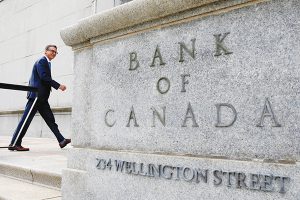Bloomberg
The Bank of Canada’s No. 2 official said the country’s financial system will be able to weather growing stability risks stemming from higher interest rates and inflation that’s causing hardship for many households.
In prepared remarks of a speech delivered in Ottawa, Senior Deputy Governor Carolyn Rogers said risks for Canada are mitigated by financial reforms since the 2008-09 financial crisis that shored up capital and liquidity buffers. The country is also not expected to be hit by a “severe†economic downturn that generates large job losses, she said.
“There are good reasons to believe that the system as a whole will be able to weather this period of stress and remain resilient,†Rogers said.
Rogers highlighted how the steep increase in interest rates may be causing financial stress to Canadians who have recently bought a home with variable-rate mortgages. She said about 670,000 new mortgages were taken with variable rates since the onset of the pandemic and about 50% of all loans since mid-2021.
That’s left many Canadians vulnerable to rising borrowing costs. In a research paper released with the speech, the Bank of Canada estimated that about 50% of variable-rate, fixed-payment mortgages have reached the point where additional payments may be needed. That’s about 13% of all Canadian mortgages.
Still. Rogers flagged how Canada’s stringent mortgage stress test is ensuring “Canadians could continue to afford their homes when interest rates rose.â€
In the speech, Rogers reiterated the central bank is starting to see its aggressive interest rate hikes starting to work to slow economic growth and bring price pressures to heel, though “we have a long way to go to get inflation back to target.â€
Before the speech, traders were betting on about a one-third chance policymakers hike interest rates by another 50 basis points at the next decision on December 7. The overnight rate is currently 3.75%, up 3.5 percentage points since March.
The central bank, led by Governor Tiff Macklem, has been signalling its intent to continue tightening policy until it sees “clear evidence†inflation has started returning to its 2% target from about 7% currently.
But there are limits to how far borrowing costs can go due to Canada’s high level of household indebtedness. Investors will be watching for any hints from Macklem that the end of his hiking cycle is near.
Policymakers are increasingly worried about growing financial stability risks associated with higher interest rates. There’s also speculation Federal Reserve Chairman Jerome Powell will start planning for a reduction in the size of increases after an expected three-quarter point hike next week.
 The Gulf Time Newspaper One of the finest business newspapers in the UAE brought to you by our professional writers and editors.
The Gulf Time Newspaper One of the finest business newspapers in the UAE brought to you by our professional writers and editors.
